What Is Government Cheese And How It Got That Name
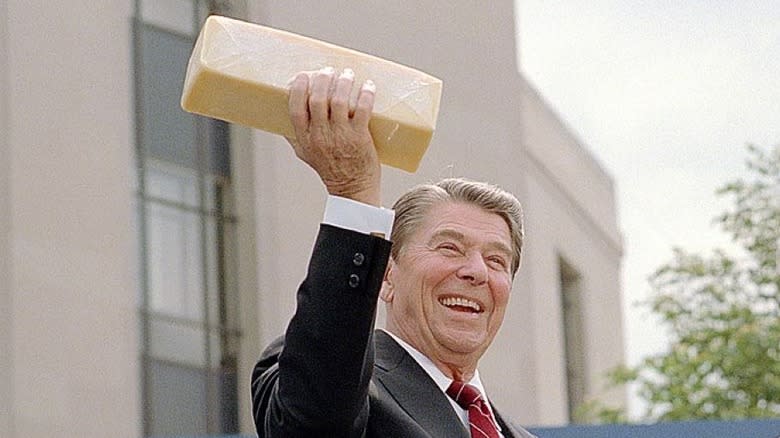
Have you ever heard someone mention government cheese and not know what they were talking about? Do you have some vague memory of people receiving blocks of cheese from the government, and then the program going away suddenly? Well, sit tight; we've got the story of government cheese here, and you may learn more than you wanted to ever know about it.
Government cheese was a processed cheese product that the U.S. government sent to thousands of families along with other staple foods in the 1980s. It was supposed to help people at a time when the economy was not doing well, and it did. But the story is not as rosy as that, as there were other reasons at play when the government started the program. And there were things about that cheese that made it not very appetizing, yet the government sent it to people anyway. Read on to find out more about the history of government cheese in the U.S.
Read more: 16 Little-Known Facts About Salt
The Road To Too Much Cheese Was Paved With Good Intentions (For Farmers)
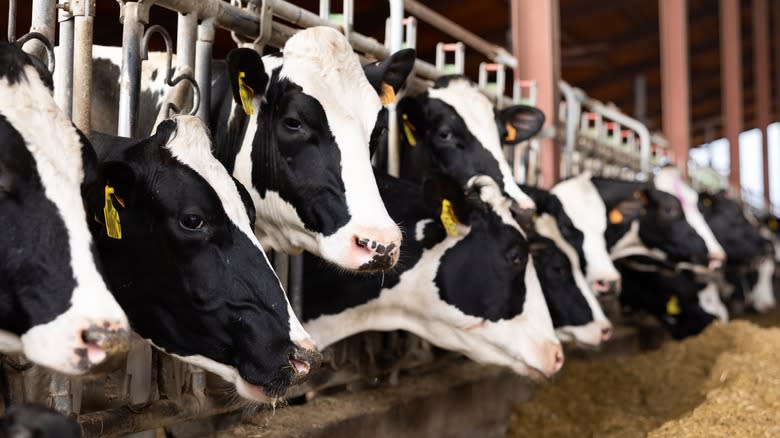
The U.S. originally didn't have a cheese surplus, but it did have unhappy, struggling dairy farmers. Back in 1949, the U.S. Department of Agriculture attempted to help out those farmers by creating the Dairy Product Price Support Program. In a nutshell, the program allowed the USDA to buy excess dairy products to help control the price of dairy on the commercial market. If the price of dairy was so low that farmers were hurting, the USDA could swoop in, buy up excess product so that it wasn't swamping stores and causing lower prices. Then, when the price rose again (specifically to 125% of the USDA's purchase rate), the USDA would start releasing the stockpiled dairy.
When the early 1970s arrived, the economy was bad and prices were high. This included milk prices due to inflation and a dairy shortage. In the late 1970s, the government attempted to stabilize the situation by giving dairy farmers billions in subsidies that soon had them producing excess amounts of milk. The problem was that the price support program's purchasing requirement was still in effect, so the USDA was buying more and more dairy. Milk spoils easily, so the USDA had it made into products like processed cheese, and stored everything in warehouses spread throughout 35 states. The stockpile at its highest point may have reached over 500 million pounds. The price support program finally ended in 2014.
The Distribution Of Government Cheese Wasn't Started Solely To Help Poor People
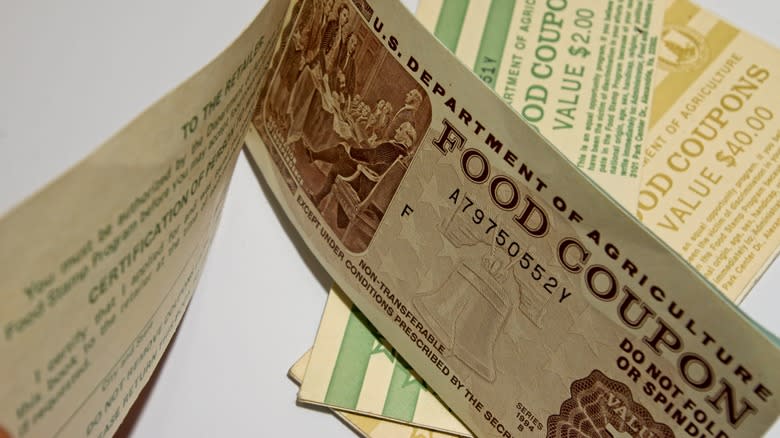
With the stockpile of various dairy products growing and growing, the government had to figure out what to do with it. After all, cheese and milk powder can last a long time, but they aren't totally immune to spoilage. The government had converted all that milk into other products without actually understanding how long they could store them before the products went bad. Unfortunately, by 1981, they were already spoiling. When the secretary of agriculture very publicly displayed a block of rotting cheese to the press, public opinion turned sour toward the government because the country was already struggling with a poor economy. All that food deteriorating in warehouses while people were still having trouble? That didn't look good.
The decision was made to distribute the cheese to Americans. Then-President Ronald Reagan spun it as government assistance, creating a program called the Temporary Emergency Food Assistance Program (TEFAP) that would distribute the cheese. The government also sent the cheese to food pantries and schools for their lunch programs. The cheese wound up helping a lot of families, but the cheese distribution apparently started because the government had a public relations disaster on its hands.
The Program As People Remember It Stopped In The 1980s
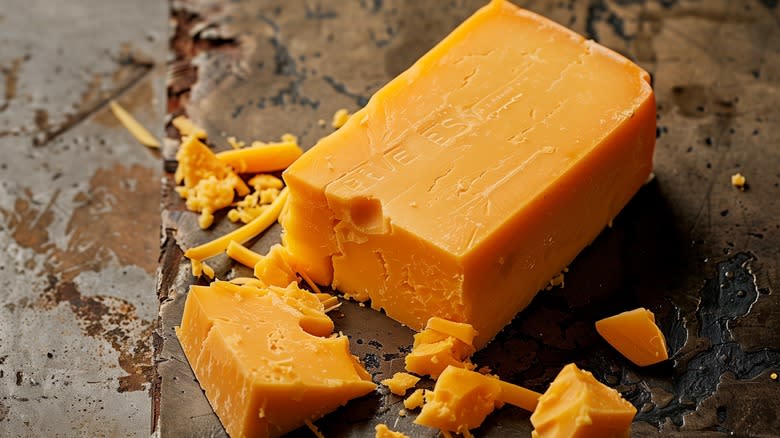
The distribution of government cheese as people remember it from the Reagan years ended back in the 1980s, but not before about 300 million pounds of the cheese made it out of the stockpile and into kitchens. By 1988, much of the surplus was gone, and the Temporary Emergency Food Assistance Program Changed its name in 1990.
The government cheese distribution had been so successful at reducing the stockpile that the emergency assistance program didn't have much to distribute. The government had to authorize the Hunger Prevention Act in 1988 to provide money that could buy products to distribute through the program, while the USDA continued to donate what it could. Since then, the government has been in and out of the business of dealing with extra cheese, including several years when the USDA encouraged fast food companies to vastly increase how much cheese they used in foods like tacos and sandwiches.
Some Of The Cheese Was Apparently Moldy
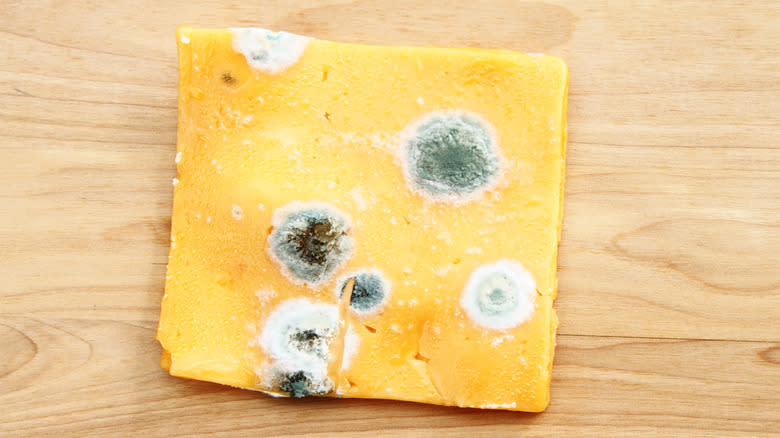
We mentioned that the cheese in storage had begun to spoil. Specifically, it began to turn green and develop mold, and the block that the secretary of agriculture showed to the press was not just rotting, but was visibly moldy. And anecdotes recount how the cheese sent to families as part of the government cheese distribution would sometimes have mold.
Given that this was a processed cheese, that sounds like a complete waste. But some recipients were in such dire straits that the mold didn't matter. At one Salvation Army center in Illinois in 1982, people were so in need that when staff members tried to throw out 680 pounds of moldy cheese because they didn't think it was appropriate to feed it to people, those people took the cheese out of the dumpsters. According to one staff member, the mold wasn't actually that bad; it was just appearing around the edges, but the higher-ups didn't want to feed people "garbage."
Some People Really Liked It
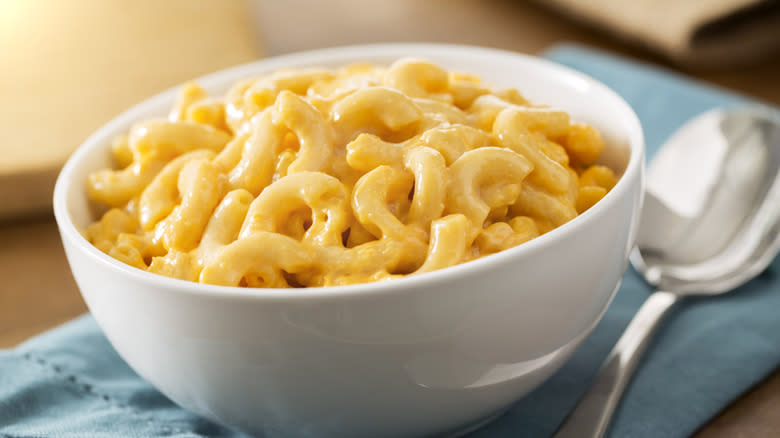
Government cheese developed quite a reputation. For some, it was an unpleasant and very public reminder of what was happening to them economically; it's hard to hide a 5-pound cardboard box of cheese, and even if no one else saw it, the families receiving it saw it. For many, the cheese was an overly salty, weirdly waxy-textured food that didn't evoke good memories of any meals.
But for others, the cheese was the best. It melted very well for dishes like grilled cheese and macaroni and cheese, and is often compared to processed American cheese like Velveeta or Kraft, just with a harder texture. Some apparently liked it so much (or were so hungry for the food help) that they'd eat it straight, without cooking it. People's memories differ on what exactly it tasted like, but even those who don't ever want to use it again say they'd be tempted to take a bite just for the nostalgia.
The Government Started Buying Up More Cheese In The Late 2010s

The agriculture subsidy program that required the USDA to purchase or sell cheese and other dairy at certain prices continued throughout the 1980s and beyond, but it underwent a drastic change: The department was no longer required to sell the cheese once the price reached 125% of the USDA's purchase price. The secretary of agriculture would be the one to make the final decision. That led to political problems, and the price support program became untenable and had to end.
But the purchase of cheese by the government reared its head again two years after the price support program ended. In 2016, dairy prices were once again very low, and farmers were dumping milk as a result. The government stepped in and purchased $20 million worth of cheese to help out the farmers, and redistributing it to food assistance programs. And in 2018, the dairy industry came close to asking the USDA to step in again. The government continues to hold a cheese surplus, although it's now much, much smaller and is overshadowed by the cheese surplus stored by dairy producers. The overall surplus, both government and private, reached 1.4 billion-with-a-B pounds in 2019.
The Government Still Hands Out Cheese, Just Not In 5-Pound Blocks
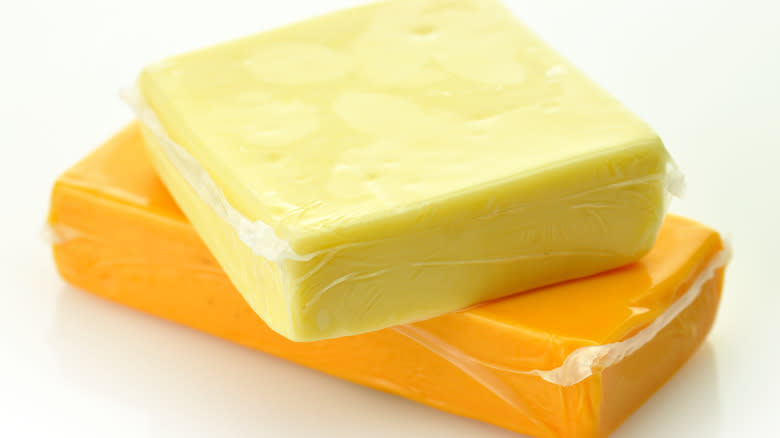
The Temporary Emergency Food Assistance Program may have ended in the late 1980s and undergone a name change in 1990 to The Emergency Food Assistance Program, but it didn't fully give up on government cheese. Those 5-pound blocks of cardboard-wrapped cheese may be no more, but government-distributed cheese still makes its way into relief packages. For example, cheese was part of a pandemic food assistance box in 2020, and it's been a part of food assistance boxes for low-income seniors for years. Sometimes the cheese and other surplus food products were sent as part of aid to disaster areas.
Then there are those times when the USDA reverts back to its surplus-buying ways. When the USDA bought up the excess dairy in 2016, it did so with the specific plan of sending it to places like food banks starting in 2017. The cheese is now sent in smaller blocks and is wrapped in plastic, but it remains a core part of those packages.
It's Currently Stored In Caves
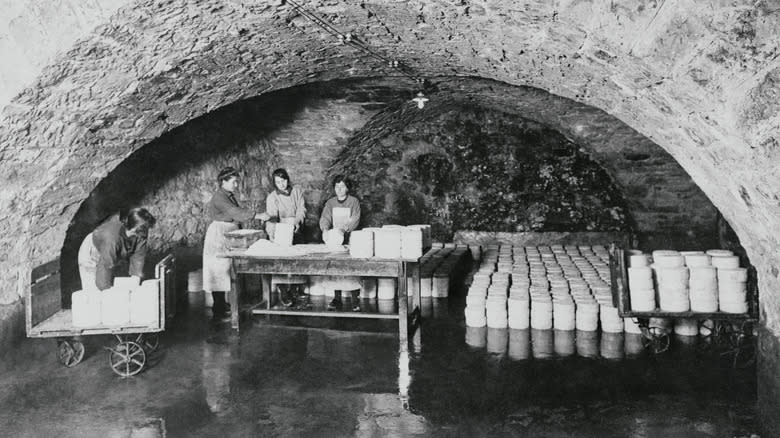
When you have an excess of cheese that needs to be kept cool, where can you store it safely? Your typical warehouse looks big, but in reality, many conventional warehouses don't have enough space to store billions of pounds of cheese, not to mention all the other associated surplus dairy. You need a special storage area. How about an underground network of caves? Cheese caves really are a thing in the cheesemaking world because the cooler environment within is perfect for aging cheese and storing it to hold off spoilage. But in the government's case, this is not an artisanal storage area.
Under the city of Springfield, Missouri, is a network of man-made caves that are protected enough from the outside environment that they're naturally cooler. This network acts as a giant warehouse for storing foods like cheese and is called the Springfield Underground. The Underground opened in 1946 and rents out space to about 50 different companies. The caves are wide enough for semi-trucks to drive through easily. Unfortunately, you can't visit the Springfield Underground; it's a commercial complex, not a state attraction. However, news channels have been given tours before and may have videos posted online.
Technically, The U.S. Government Isn't The Owner
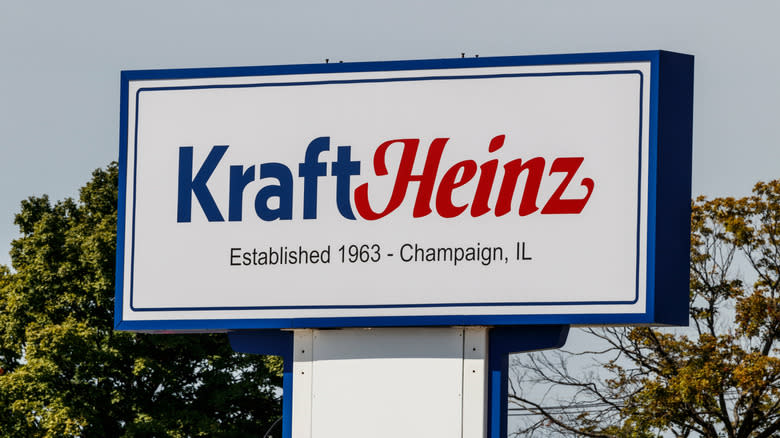
Or at least, the U.S. government isn't the owner of most of the cheese. The Springfield Underground holds dairy products from many companies such as Kraft Heinz, and as of 2022, only about a fifth of the stockpile was directly owned by the USDA. The rest is privately owned and merely stored in the same place, and it's not necessarily surplus. Some are actually being aged by companies before heading for sale.
While the U.S. government does still purchase cheese, it's usually sent to food assistance programs rather than long-term storage. The cheese stored in the caves is apparently used for military food supplies. However, that hasn't stopped people from creating wild stories around the cheese and making a mystery that isn't really there. Even the head of the industrial group that includes the Underground has said there's always someone who thinks they've discovered a huge mystery even though the Underground has been around -- and storing cheese -- for decades.
It's Not The Only Surplus Food Stored In These Caves
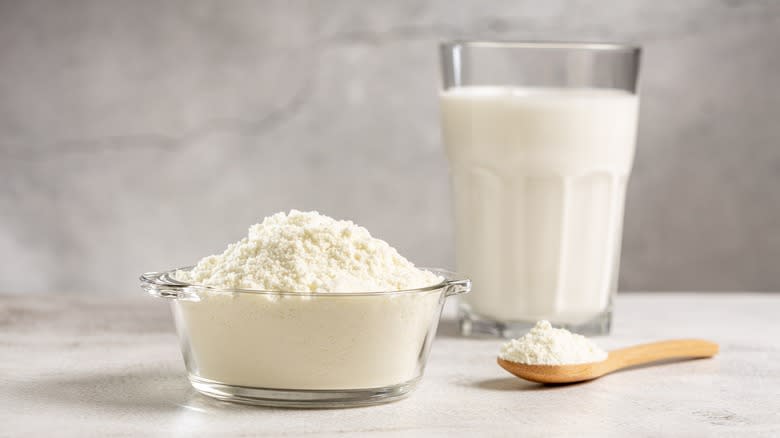
Cold storage in an underground cave is great for cheese, and it's great for any form of dairy that doesn't have to be frozen. The companies that rent space in the Springfield Underground understand this well and have stored several types of food there. Products include milk powder, liquid milk, and butter in addition to all that cheese.
Is it safe to store food in these caverns? Obviously, the temperature control is good, but the ambient temperature hovers in the low 60s, which is too warm for refrigerated food. No fear; the Underground contains sections that have extra refrigeration to keep that food safe, plus dry storage sections for items that don't need refrigeration. Crews ensure the location remains sanitary for food storage. If you find you're eating cheese aged or stored in the caves, that cheese should have been stored safely.
It's The Best Cheese For Grilled Cheese
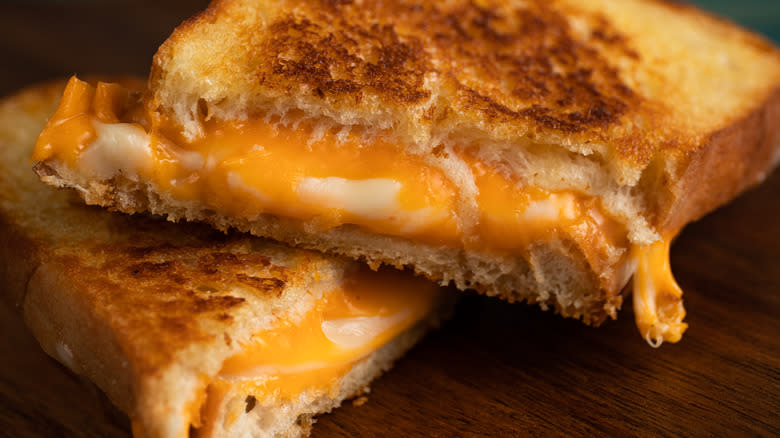
Government cheese had a texture that not a lot of people found enticing. It wasn't something that many people ate raw, and the raw texture has been described as too hard and too soft; it was a polarizing cheese. But it did melt beautifully, and a very common memory is of grilled cheese sandwiches made with government cheese. Despite its firmer texture -- it wasn't a soft and squishy cheese like slices of American can be -- it simply disintegrated over bread on a hot griddle, which is exactly what you want cheese to do when making grilled cheese.
This was actually deliberate. It turns out that the government required processed cheese used in government programs to melt easily, with a specific food-science meltability rating of Number 3 on the AMS laboratory scale, which is apparently the best level of meltability for dishes like grilled cheese sandwiches.
The Amount Stored Is Nowhere Near What Americans Eat Yearly

Nearly a billion and a half pounds of stored cheese sounds like an amazing amount, one that will last the country for several years in an emergency, right? Nope. That wouldn't even feed the U.S. for a couple of months. The amount of cheese stored in the caves, both USDA and privately owned, totals maybe a tenth of what Americans eat per year. That's about 13.5 billion pounds of cheese munched on or melted in sandwiches.
There are claims that U.S. cheese consumption is falling, but that's not what the numbers have shown. U.S. cheese consumption overall has gone up, with 2022 being a record year. The average American ate 41.8 pounds of cheese then, continuing a longstanding trend. And if you look at the consumption of American cheese specifically, even that's been rising steadily. If the U.S. government really wants to hoard dairy, it's going to have to buy a lot more to even begin to create a stockpile that would meet the U.S. desire for cheese.
Read the original article on Mashed.


